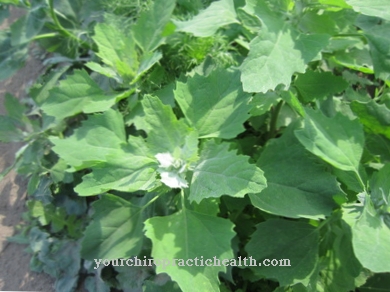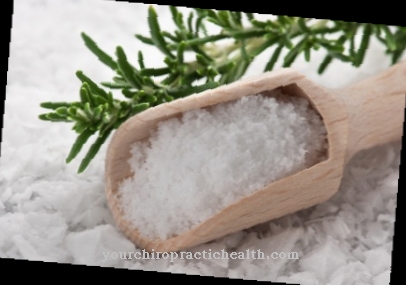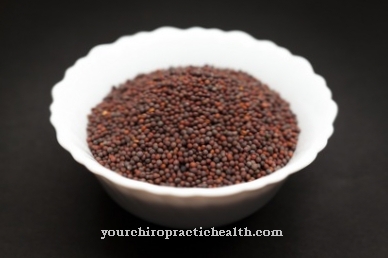cheese is a milk product made from the protein content of milk, the casein. Making cheese is one of the oldest methods of preserving milk.
What you should know about cheese

Cheese has been made from milk for centuries. This actually occurs when milk becomes acidic. Then the solid components such as fat, minerals, protein and lactose settle and separate from the liquid milk whey.
The origin of cheese production probably dates back to the Stone Age. The original form of the cheese is fermented rennet curd, which the Stone Age hunters discovered in the stomach of their prey. Domestication of sheep, goats and cattle began in the 10th century BC. This gave people greater amounts of animal milk. In order to make them more durable, they developed cheese production. For this, the milk was first acidified in the sun or over the fire and then made curdable. Animal and vegetable coagulants were later added. This is how rennet cheese was made.
Even noble mold was used early on for preservation and taste improvement. The noble mold cheese was probably created when cheese was stored in caves with a corresponding mold flora. The oldest evidence of cheese production dates back to 5500 BC. In what is now Poland, the remains of cheese eggs were found that were then used to skim the whey. An important source that proves the development of cheese making in Europe are the records of the monasteries of that time. Through the writings of the monks, some types of cheese that are still produced today can be traced back to the year 1100. For example, the Emmentaler was first mentioned in 1200 and the Gouda in 1184.
In the course of the 19th century, cheese production was facilitated and improved by numerous scientific discoveries and technical developments. Today's cheese making is still based on the same principles as cheese making in the past. In a first step, the milk is strained and heated. This step is skipped in the production of raw milk cheese. The fat content of the cheese is determined by how the milk is skimmed. The skimmed milk is then mixed with cream so that a defined fat content can be achieved. With the help of special lactic acid bacteria, the starter cultures, the milk is coagulated.
The lab is also required for this process. In technical jargon, this process of curdling milk is called curdling. The curdling takes half an hour to several hours. The duration depends on the type of cheese. Thickness is created during curdling. When it is properly firm, it is cut into pieces with the help of a cheese harp. This stage is also known as cheese curd. The following applies: the finer the structure of the curd, the more whey will settle. The more whey settles, the harder the cheese will later be. Smaller broken grains are therefore required in the production of hard cheese.
Soft cheese requires large broken grains. When the cheese has reached the right consistency, it is poured into molds. Then the remaining whey is removed by pressing and draining. After molding, all cheeses are bathed in brine. This will remove harmful bacteria. In addition, the bath in the brine stimulates the formation of the cheese rind. The cheese rests in the final stage of cheese production. During the ripening process, the cheeses must be turned regularly. Depending on the variety, they are also brushed or treated with mold. The process can take weeks or months. It gives the cheese its final taste.
Importance to health
Cheese contains the nutrients in milk in a concentrated form. Like milk, cheese is relatively high in calcium. In doing so, it helps keep bones and teeth healthy. A calcium deficiency leads to tingling sensations, increased reflexes, muscle twitching and a slowed heartbeat.
Depression or anxiety can also occur. Cheese not only contains calcium, but also vitamin B12. The body needs vitamin B12 for the formation of red blood cells (erythrocytes). Vitamin B12 is also responsible for the normal function of the immune system and the nervous system. Cheeses with a fat content of less than 65% contain a lot of protein. Proteins perform various tasks in the body. They are building blocks of the muscles, serve to maintain the bones, act as a transport medium for water-soluble substances in the blood and are part of hormones.
Ingredients & nutritional values
The amount and proportions of ingredients in the cheese vary depending on the type of cheese. The type of milk, the breed of animal, the feeding, the keeping and the production methods also have an influence on the ingredients. In their basic structure, however, all types of cheese are similar. Every cheese contains water. The water content determines how firm the cheese is. The protein content of cheese is between 10 and 30% depending on the fat content. The protein in cheese contains many essential amino acids.
The body cannot produce these by itself and is therefore dependent on supply from food. The protein in cheese has good bioavailability; H. it can be easily absorbed and used by the body. Cheese contains a relatively high percentage of fat. The fat content is calculated in the dry matter of the cheese. In this way, the cheese can be assigned to different fat content levels. The carbohydrate content in cheese is relatively low. Depending on the type, cheese contains between 1 and 3 g of carbohydrates per 100 g.
Intolerances & allergies
Cheese is generally well tolerated. Because it is made from milk and lactose is a natural component of milk, people with lactose intolerance also react to cheese. Lactose intolerant people do not have to do without cheese completely, as many types of cheese are now made lactose-free. Gouda, mountain cheese, Appenzeller cheese and Parmesan in particular are generally lactose-free. Cream cheese, cream and processed cheese, on the other hand, contain lactose.
Shopping & kitchen tips
Regardless of whether it is cheese from the refrigerated shelf, from the cheese counter or from the delicatessen, a few rules should be observed when storing cheese. This is the only way for the cheese to retain its full taste.
Cheese should be stored in a dark and cool place with low humidity. The cheese matures in warm temperatures. In the refrigerator, cheese is best kept in the vegetable drawer. All types of cheese, with the exception of the cream cheese, must not be packed airtight. Otherwise you can no longer breathe and quickly start to get moldy.
Preparation tips
Cheese can be used to make a variety of dishes. It tastes good on bread, belongs on every pizza and is suitable for gratinating casseroles and gratins. A cheese platter offers a special treat. Grapes, figs, pears, walnuts or radishes are suitable for decoration. 5 to 9 types of cheese should be combined for a good cheese platter. It is advisable to take the cheese out of the refrigerator half an hour before consumption. Then it can develop its full aroma and taste particularly good.



























